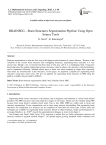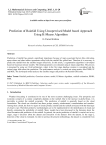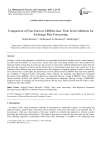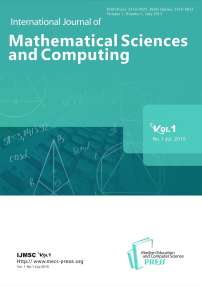Cover page and Table of Contents. Vol. 1 No. 1, 2015, IJMSC
Бесплатный доступ
ID: 15010107 Короткий адрес: https://sciup.org/15010107
Статьи выпуска 1, 2015 International Journal of Mathematical Sciences and Computing(IJMSC)

BRAINSEG – Brain Structures Segmentation Pipeline Using Open Source Tools
Статья научная
Structure segmentation is often the first step in the diagnosis and treatment of various diseases. Because of the variations in the various brain structures and overlapping structures, segmenting brain structures is a very crucial step. Though a lot of research had been done in this area, still it is a challenging field. Using prior knowledge about the spatial relationships among structures, called as atlases, the structures with dissimilarities can be segmented efficiently. Multiple atlases prove a better one when compared to single atlas, especially when there are dissimilarities in the structures. In this paper, we proposed a pipeline for segmenting brain structures using open source tools. We test our pipeline for segmenting brain structures in MRI using the publicly available data provided by MIDAS.
Бесплатно

Prediction of Rainfall Using Unsupervised Model based Approach Using K-Means Algorithm
Статья научная
Prediction of rainfall has gained a significant importance because of many associated factors like cultivating, aqua-culture and other indirect parameters allied with the rainfall like global heat. Therefore it is necessary to predict the rainfall from the satellite images effectively. In this article, a segmentation algorithm is developed based on Gaussian mixture models. The initial parameters are estimated using k-means algorithm. The process is presented by using an 2-fold architecture, where in the first stage database creation is considered and the second stage talks about the prediction. The performance analysis is carried out using metrics like PSNR, IF and MSE. The developed model analyzes the satellite images and predicts the Rainfall efficiently.
Бесплатно

Comparison of Four Interval ARIMA-base Time Series Methods for Exchange Rate Forecasting
Статья научная
In today's world, using quantitative methods are very important for financial markets forecast, improvement of decisions and investments. In recent years, various time series forecasting methods have been proposed for financial markets forecasting. In each case, the accuracy of time series methods fundamental to make decision and hence the research for improving the effectiveness of forecasting models have been curried on. In the literature, Many different time series methods have been frequency compared together in order to choose the most efficient once. In this paper, the performances of four different interval ARIMA-base time series methods are evaluated in financial markets forecasting. These methods are including Auto-Regressive Integrated Moving Average (ARIMA), Fuzzy Auto-Regressive Integrated Moving Average (FARIMA), Fuzzy Artificial Neural Network (FANN) and Hybrid Fuzzy Auto-Regressive Integrated Moving Average (FARIMAH). Empirical results of exchange rate forecasting indicate that the fuzzy artificial neural network model is more satisfactory than other models.
Бесплатно



